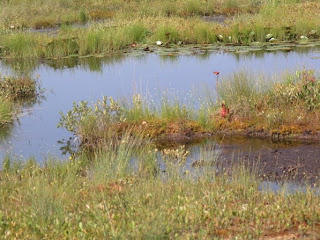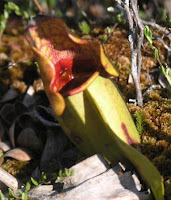
Bog.
A small word. A simple word.
It derives from the Gaellic term "bogach", meaning a soft marsh. In Anglo slang it was a common vulgarity used to describe the outhouse of the times. In currently use, we say that a puzzle boggles the mind. Spend too much time trying to solve the puzzle, and we say that you've become bogged down. Take a break by shaking the inscribed dice in their plastic enclosure to spell out words with the resulting letters. You're playing Boggle. But go into the woods and find a basin filled with water, sphagnum, and peat - congratulations! You're standing in, or should I say on, a bog.
Bogs are beautifully, delicate environments. Smalls plants in all shades of greens and red hues are occasionally interrupted by unexpected bursts of yellows, violets, and ombres. Surrounded by coniferous forests, the basin of the bog represents an ever-shifting balance between land, sphagnum, peat, and rainwater that flows into the basin. Typically, there are no streams that feed water to bogs, only precipitation. For this reason, bogs are considered to be ombrotrophic, and the water they contain is quite acidic and lacking in mineral nutrients.
This environment suits certain types of life quite nicely. This is especially true for sphagnum moss. You've probably seen sphagnum in you florist shop, especially if you've looked at large ferns in wire hanging baskets. These ferns' roots are usually encased in sphagnum. Or perhaps you've seen the moss in my millipede's tank. That too is sphagnum. Both the fern and the millipede benefit from sphagnum's primary characteristic: it is capable of holding a large volume of water. In that sense, it is like a sponge.
Over time, sphagnum compresses and solidifies into peat. Newly formed areas in the bog are covered with a relativly thin layer of sphagnum and peat. Older areas contain more peat, and are thicker. These areas provide greater support. The sphagnum/peat layer floats on top of the water contained in the bog. Over long periods time, areas in the bog become filled in with peat, and turn into terra firma. Eventually this land provides a foundation for the ever-encroaching coniferous forest that surrounds the bog. In time, the bog will disappear.
Standing on a layer of sphagnum/peat in a bog is like standing on a waterbed. Some areas are simply squishy. Some are quite dry. But many areas allow a person to gently shift their weight up and down, to and fro, while the ground seems to sway in waves beneath you. It takes a little getting used to. Just imagine yourself walking on a large bowl of Jell-O. Or perhaps a cracker floating on a bowl of soup. It's great fun, just as long as you exercise a degree of caution.
The temptation to edge just a little bit closer to take a close-up picture of that beautiful plant on the water's edge is always there. Just a little closer. "Yes, I'm sinking, but just a few centimeters. Just a little more." ("Gary....") "I'm OK...just a little closer...." ("Gary you really don't want to go there") Good student that I am, I always listen to my instructor's sage advise. Especially when he has nearly three decades of botanical experience.
It's one thing to walk near the edge of land. It's another thing to fall off the edge. I feel like Alfred Wegener on tectonic plates of Jell-O, searching for the boundaries of Pangea.
The very thought boggles the mind.
 An old fashioned winter...lots of snow. About a foot today, another 10-12 inches expected tomorrow, with some more expected to come down on the eve of Christmas Day. This picture was taken the morning following last week's ice storm. Something in the original image caught my eye, and looked vaguely familiar. Isolating the tip of the branch on the yew plant and rotating it 90 degrees revealed more clearly what I saw in the image. A miniature ice sculpture of a seahorse.
An old fashioned winter...lots of snow. About a foot today, another 10-12 inches expected tomorrow, with some more expected to come down on the eve of Christmas Day. This picture was taken the morning following last week's ice storm. Something in the original image caught my eye, and looked vaguely familiar. Isolating the tip of the branch on the yew plant and rotating it 90 degrees revealed more clearly what I saw in the image. A miniature ice sculpture of a seahorse.

